INTRODUCTION
After testing the DIR-880L Wireless AC1900 Dual Band Gigabit Cloud Router by D-Link roughly a week ago some of you asked us if you should prefer external antennas over internal ones when purchasing a router or a modem/router so that you can have the best possible wireless performance. Unfortunately we don't have a valid answer for that since to date we've recorded very good numbers with models using both types (although models with external antennas seem to be doing just a tad better). My recommendation is to check our charts (or charts from other media for that matter) to see for yourselves which models do better in that area and decide based on that and not on the type of antennas used. With that out of the way today we'll be testing yet another model with internal antennas, the TEW-824DRU AC1750 Dual Band Wireless Router with StreamBoost Technology by TRENDnet.
Founded in Torrance, California, TRENDnet has grown to become a leading global networking hardware brand. From the network core to the periphery, TRENDnet's expansive product portfolio includes Wireless, Wired, Surveillance, Connectivity, and Peripheral device categories. An emphasis on continual improvement and our ISO 9001:2008 quality management certification (click here to view certificate) is an essential component of TRENDnet’s success. The TRENDnet brand is consistently recognized for exceptional quality, superior performance, and responsive support. TRENDnet's vision is to build innovative, easy to use, and reliable Networks People Trust™. TRENDnet solutions network the countless devices which enable your connected lifestyle and workplace. Building award winning networking solutions since 1990, TRENDnet connects you with what you value most.
Unlike the previously reviewed TEW-818DRU AC1900 modem-router again by TRENDnet which used a Broadcom processor the brand new TEW-824DRU AC1750 model actually features one by Qualcomm Atheros and more specifically the QCA9558 dual-band, 3-stream 802.11n system-on-chip (SoC) clocked at 720MHz. The TEW-824DRU also features the QCA9880 3-stream 802.11ac radio solution, and the AR8327 Gigabit Ethernet switch again by Qualcomm Atheros along with 256MB of DDR3 RAM and 16MB of flash memory. As with pretty much every AC compatible router the TEW-824DRU makes use of 2 different bands to reach the advertised speed of 1750Mbps (2.4GHz/5GHz) and to do that it makes use of three 2dBi for the 2.4GHz band (N-450Mbps) and three 3dBi for the 5GHz band (AC-1300Mbps) antennas all placed inside the housing. So the time has come for us to see just how good this new router by TRENDnet based on the Qualcomm Atheros platform really is.
SPECIFICATIONS AND FEATURES

PACKAGING AND CONTENTS
The TEW-824DRU gets shipped inside a small box that has a large picture of it at the front.
Both the dual band and StreamBoost features are explained on the left side.
You can check out the features and bundle contents lists from the right side of the box.
The features list is also placed at the rear in 6 languages right beneath two product pictures used to showcase its features.
A thick cardboard box is placed inside the package.
TRENDnet ships the TEW-824DRU with its power adapter, CD containing the user manual in several languages, Ethernet cable, registration paper and the user manual.
THE TEW-824DRU
The plastic body of the TEW-824DRU should only be placed vertically and measures 191mm in height, 151mm in depth and 72mm in width (weighs 408g).
We placed the TEW-824DRU right next to the D6300B modem/router by Netgear, the FRITZ!Box 4020 router by AVM (review soon) and the TPE-S44 PoE switch again by TRENDnet to get a better idea about its size.
Unlike the TEW-818DRU the TEW-824DRU just has the power on/off LED and the Internet LED at the front (no LAN/USB activity LEDs).
Although the housing is made out of hard plastic TRENDnet has placed their logo on two thin pieces of brushed aluminum located on both sides.
At the rear we find the 4 gigabit Ethernet ports, WAN gigabit port, on/off power button and the power port.
This time over TRENDnet has used a small plastic base for the router (the TEW-818DRU didn't have one) underneath which there's a small sticker with all the necessary information regarding the router.
SETUP
Setting up the router is very easy, just plug it in your local network and access the webpage (once you launch an IE window the setup wizard should pop up).
Once you confirm some of the settings (see above screen) it will only take just a couple of minutes for the device to store them and reboot.
I also recommend downloading the latest firmware update from the TRENDnet website and install it as soon as you enter the web interface (from the setup tab).
WEB INTERFACE PART 1
Just like with most routers and modem/routers in the market you can check the status of the device at a glance from the main screen.


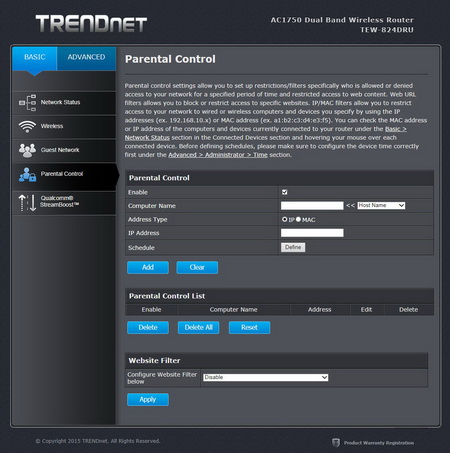

The web interface has two columns, basic and advanced. From the basic you can access the wireless settings, enable/disable the guest wireless network (useful for businesses), enable/disable parental controls and also enable/disable and check the status of the StreamBoost feature.
This feature is quite interesting (nothing new however since it's been around for 2-3 years already) but we do need to point out that once we enabled the automatic updates function the web interface stopped responding. Everything was working but we just couldn't access the web interface until we powered the device down and then up again so do keep that in mind just in case this happens to you too.
WEB INTERFACE PART 2



From the administrator page under the advanced tab you can check the status of the router, check system logs, enable/disable UPNP, use WAN ping, import/export settings, and setup the time.
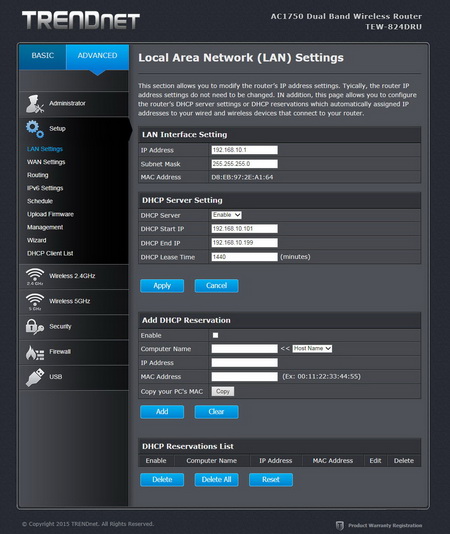

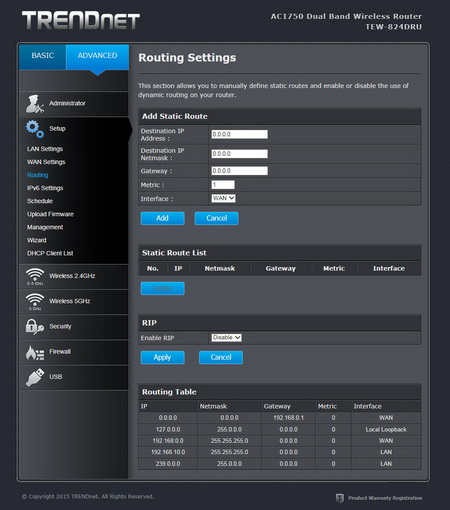

The setup page has pretty much everything else so from here you can adjust the LAN and WAN settings, add static routes, configure IPv6, upload new firmware updates, setup user access, enable remote access, start the setup wizard and check the DHCP client list.



From the two wireless pages you can adjust a plethora of WiFi settings including the signal strength, type of security and WPS.
As the name suggests the security page allows the user to enable/disable access control, add rules to block services and configure the inbound connections filter.


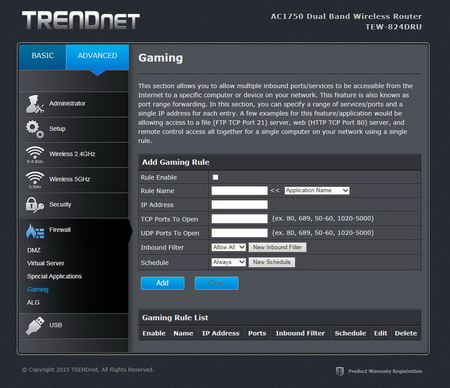

Through the firewall page you can setup the DMZ and Virtual Server options, enable/disable special applications and game rules and configure the application level gateway.


Finally the USB screen allows you to use a USB connected storage device for file sharing and/or as an FTP server.
TESTING METHODOLOGY
Since standalone routers can't directly connect to the internet (unless you have a cable connection which we don't) and thus the modem is responsible for internet speeds the only thing that's left is to test and see how much bandwidth they can offer by directly linking two devices with them. So once again we will be using the networking benchmark by Passmark (v.8) and the QCheck by Ixia to test such devices the same exact way we test Powerline adapters and Modem/Routers. Since we need to test new features and specifications all routers are benchmarked with their highest available wireless standard/band (5GHz in this case). Our systems are placed 15m away from the router with 3 concrete walls between them while each test is repeated a total of 6 times after which the average scores are recorded into our charts. Both systems have Windows 7 Ultimate SP1 installed with all the updates until the 18th of December 2015.
TEST RESULTS



CONCLUSION
As you can all tell just by taking a quick look at our charts ATTO really likes Qualcomm Atheros StreamBoost technology since the TEW-824DRU surpassed all others in that test and by a large margin (write performance). Unfortunately although we did get on a great start the same didn’t happen while testing the router with the QCheck and Network Test programs so in the end you need to decide which you trust most. That being said the TEW-824DRU offers very good overall performance and offers a wealth of available settings most of which casual users will probably never even touch. TRENDnet has been using this web interface for quite some time now but aside the dark color we like it and since haven’t come across any problems with it we’re not complaining. The lack of forward LAN activity LEDs and a USB 3.0 port is perhaps the only drawback I can actually think of and since this is a 2015 model I really can’t figure out the reason behind that decision. On the other hand the TEW-824DRU does feature a power on/off button so it’s not all bad.
Price has always been one of TRENDnet’s strong points and with a current price tag set at USD89.99 inside the USA (Amazon.com) and 124Euros inside the EU (Amazon.co.uk) I’d say the TEW-824DRU is not really an exception (although EU pricing needs a small “tuning”). Bottom line the TEW-824DRU is the ideal choice for people looking for a router which combines very good wireless performance with a large number of available settings at a very tempting price tag (USA) and that’s why it gets our Golden Award.
 PROS
PROS
- Size
- AC1750 Technology (Concurrent 802.11n 450Mbps & 802.11ac 1300Mbps Bands)
- User Friendly Web Interface
- Plethora Of Features/Settings
- Supports StreamBoost/DD-WRT (Open Source OS)
- 4 Gigabit Ethernet Ports
- Price (USA)
CONS
- Price (EU)
- Single USB 2.0 Port

 O-Sense
O-Sense





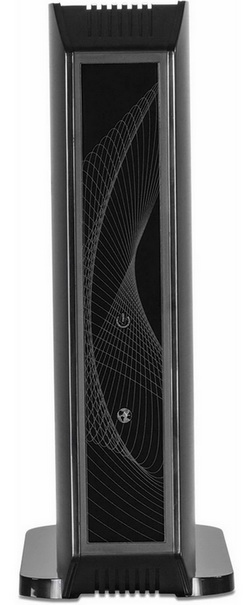






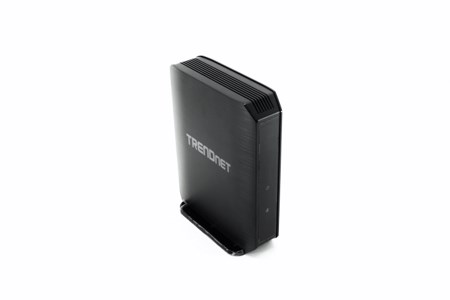















.png)

